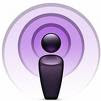
What is a podcast?
A podcast is an audio or video program uploaded to the internet along with a specific type of text file about the uploaded media file. This text file allows the audience to subscribe to the program.
Podcasts can be any length, range from having professional-sounding production value to none at all, and their subject matter can be anything. Some popular topics include news & politics, art, literature, music, travel, comedy, cooking, technology, education, fashion & beauty, UFOs, and podcasting.
How does one create a podcast?
1. Record an audio or video program
Some computers come with built in microphones, others even have built in video cameras -- using these tools an easy and quick way to create your media file. Using these tools in conjunction with full-service podcast hosting/media creation sites like
Hipcast or
SwitchPod. If your computer has a microphone and/or video camera attached to it, these services allow you to record audio and/or video right through your browser, and you can skip steps two and three below.
For higher quality and greater mobility, consider using a digital camera in movie mode, a digital video camera, or (for just audio) a digital audio recorder. Of course if your choice is analog recording, any media can be digitized and transfered to your computer, you'll just need some extra equipment and time.
Once you have your media file recorded you may want to edit it. For audio files,
Audacity is simple software that is absolutely free. For talk-only podcasts I use
Amadeus Pro, and for mixed talk and music podcasts I use
Audio Hijack Pro, which lets you "hijack" and mix together any audio coming through your computer. If you plan to do phone interviews, AHP enables you to record voice-over-IP (VOIP) conversations via
iChat,
Skype, or whatever you use.
QuickTime Pro is simple, inexpensive editing software, and
iMovie (part of Apple's $79
iLife package) has even more flexibility and power. At the high end you could work with professional video editing software like
Final Cut Pro. Simple edits like
removing unwanted noise from the audio or adding in a brief musical introduction can go a long way to making your podcast more appealing.
2. Convert the media file to a web-friendly size and format
Most of the aforementioned software has this capicity built-in as a Save As... or Export As... function. Another easy way to do this is to import the media file into iTunes. Once it's in your iTunes library, select the file and under the Advanced menu select Convert Selection to MP3 (for audio) or Convert Selection for iPod (for video).
3. Create an RSS feed with enclosure to describe the media file
An RSS feed is a text file that acts as a roadmap to where your podcasts (media files) live, how often they are updates, and allow people to subscribe to your podcast so that every time you post a new episode, the media file is automatically delivered to them. Podcast-creating software like the free
VODcaster, or the $30 Podcast Maker will do the heavy lifting for you. All you need to do is tell the software where on the internet your files will live (in a folder on your own site, or at a
podcast host), and fill in as much other descriptive information as you'd like, and the software will generate the feed code for you. You can also use this online
RSS feed generator, or if you want to learn how to create your own podcast feed check out this
annotated .XML file.
4. Upload the media file and RSS feed file to the internet
If you are using a podcast host like
Libsyn or
Hipcast, you can upload your files through their web interface as easily as uploading photos or attaching documents to e-mails. If you are hosting the files on your own server somewhere, you will need a piece of file transfer protocol (FTP) software like
Transmit (feature rich, $30) or
Cyberduck (functional, free).
5. Let people know you have made your very own (life-changing, oh-my-stars you gotta hear this, amazing) podcast
Get your podcast listed in podcast directories like
Podcast Alley,
Podcast.net,
PodShow, and
iTunes. There are others, but if you only have time to list your show with a few at first, these are a good place to start.
Post to your blog about your new podcast (and include a link to the feed so that your readers can subscribe), and send an e-mail to everyone you know that might enjoy your show.
Now that you have a podcast online and ready to go, and it is listed in the directories, and you've informed your blog readership and your e-mail list about it, what's next?
Produce another episode. Make yourself a podcast creating and publishing schedule and stick to it so that your audience knows that it can rely on you to produce solid content every day/week/month, whatever time frame works for you.
If you plan to include music in your podcast, be sure to get persmission from the rights holder of the music, even snippets. Artists can often be contacted through their websites, and they will refer you to the person (usually the record label) who can grant the necessary permission. Another way to incorporate music is to find "podsafe" music that has been pre-cleared by the rights holder for use in podcasts.
Podsafe Music Network,
IODA Promonet, and
Podsafe Audio are three sites that aggregate podsafe music.
Once you get a following if you'd like to offset your costs, you can consider accepting direct advertising within your podcast, or you can sign up with podcast ad-insertion services like
Kiptronic or
Blast Podcast. Don't expect to get rich right away, but some popular podcasts certainly can provide their creators with some advertising income.


